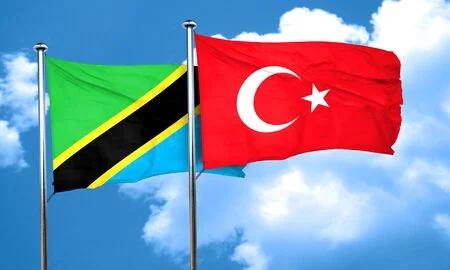By Faridah N Kulumba
Africa-Press – Tanzania. At the end of this week, Tanzania’s Work and Trasport Minister Professor Makame Mbarawa and Adil Karaismailogly Turkey’s Minister of Works and Transport met in Ankara, the capital of Turkey where they agreed on the implementation of various development projects.
The projects
Among the projects, the two authorities discussed was the modern Standard Gauge Railway (SGR) project by Turkish contractors Yepi-Merkezi has spurred further talks between the governments of the two countries to identify more areas for cooperation.
Yepi-Merkezi’s motivations
Yapi-Merkez, the Turkish contracting firm is implementing an SGR project in Tanzania involving more than two phases and has motivated the country to see the possibility of other projects implemented by the government of Tanzania.
About Yepi-Merkezi the inspirer
Yepi Markezi Holding was founded by Ersin Arioglu and Koksal Anadol in Turkey. They are a group of companies whose field of activity is mainly in the construction industry. The national and international contracting company specializes in designing and building a wide variety of buildings, rail systems, transport systems, bridges, viaducts, industrial, and heavy construction projects. Yepi Markezi has been also contracted by countries such as Saudi Arabia, Morocco, Sudan, Ethiopia, and the United Arab Emirates due to its construction standard of excellence.
The duration of implementation
The government of Tanzania will implement all the projects it had planned in Financial Year (FY) 2022 and 2023, in particular those planned for Lake Tanganyika by building a big ship to boost transport, including passenger transport in the country.
The capacity of the ship
The new ship planned for Lake Tanganyika is expected to have a capacity to carry 400 tonnes of cargo and a dry dock capable to serve a 5,000-tonne ship. The government of Turkey is ready to cooperate with Tanzania in sourcing good ship-building contractors for building ships, dry-docks, and ferries.
Tanzania and Turkey’s economic relations
Visits- Turkey and Tanzania have had a long economic relationship. The two nation’s bilateral relations were strengthened more when the former president of Turkey Abdullah Gul visited Tanzania in February 2009, and the re-opening of the Turkish Embassy in dar es Salaam in the same year. And in 2010, the former President of Tanzania Jakaya Kikwete visited Turkey. This was the first presidential-level visit from Tanzania. And also the former President of Zanzibar Al Mohamed Shein visited Turkey in 2011.
JEC- In 2012, Kenya and Turkey held their first Joint Economic Commission (JEC) meeting that took place in Dar es Salaam in Tanzania. During the meeting, the two countries reviewed bilateral economic relations and evaluated additional possibilities for cooperation.
Agreements- On 22 to 23 January 2017, the current President of Turkey Recep Tayyip Erdogan paid an official visit to Tanzania. The two days visit bore fruits on both nations’ sides. Ten agreements were signed which provided the legal basis of their relations in the various fields including industry, development, tourism, industrial economy, and communication. In the same year, the second JEC meeting between Tanzania and turkey took place in Ankara.
Trade volume- In 2015 the trade volume between Tanzania and Turkey was USD 151 million. In 2020 the trade volume increased to USD250 million. The establishment of the Embassy of Turkey in Tanzania and the launching of Turkish Airlines direct flights between Instanbul and Dar es Salaam in 2010 and Instanbul-Kilimanjaro in 2012 provided significant momentum to the bilateral economic relations between the two nations.
Tanzania’s exports to Turkey
According to the United Nations COMTRADE database on international trade, in 2021, Tanzania’s export to Turkey was USD22.02 million. Among the exports include pearls, precious stones, metals coins, cash crops, machinery, nuclear, and electronic equipment among others.
About Lake Tanganyika
Lake Tanganyika is the longest freshwater lake in the world. It is said to be the second-oldest freshwater lake in the world, the second-largest by volume, and the second-deepest, in all cases after Lake Baikal in Siberia. L Tanganyika is shared among four African countries including Tanzania, the Democratic Republic of Congo ((DRC), Burundi, and Zambia. Tanzania possesses the biggest part of the lake at 46 percent.
The benefits of ship dry-dock projects to Tanzania
Trade boosting- The implementation of this lake is aimed at spurring economic growth. The project will improve infrastructure and other supporting measures to boost trade on Lake Tanganyika and surrounding countries.
Improve exports- Lake Tanganyika is a potential corridor for imports into Eastern Congo and Burundi. While the export basket of Zambia and Tanzania is skewed towards commodities such as copper and gold, they are nonetheless more diversified economies, with agribusiness products, construction materials, and consumer products.
Competition- The competitiveness of Lake Tanganyika as a transport corridor thus depends on the competitiveness of exportable products, whether these products can be sourced from close to the lake or only from farther away, and the competition from other transport corridors. Promoting trade means not only improvements to the efficiency, cost, and reliability of lake transport matter but also efforts to promote and develop local and regional production of agribusiness and other products. Such efforts would be closely related, as private sector development would benefit from a competitive Lake Tanganyika transport corridor. Conversely, investments into a more competitive transport corridor also depend on successful private sector development.
Lake Tanganyika’s challenges to Tanzania
The potential of Lake Tanganyika is recognized by national governments, regional authorities, and international development partners. Without claiming to offer a comprehensive overview, a few key policies and activities are worth highlighting. These policies and activities face and address a range of challenges.
First, is the remote location of the lake, far away from national capitals and thus possibly the minds of policymakers.10 Second, the lake is at the boundaries of several macroregions, located between Eastern, Central, and Southern Africa, between franco-and anglophone Africa, and between the EAC and SADC. This is a further challenge as existing regional institutions or regional donor programs do not always cover all four neighboring countries.
Third, as with most regional integration activities the costs of infrastructure improvements tend to accrue to one country, while the benefits accrue also to regional partners. This creates a challenge, as without strong cooperation countries tend to invest less than is optimal from a regional point of view.
For More News And Analysis About Tanzania Follow Africa-Press







